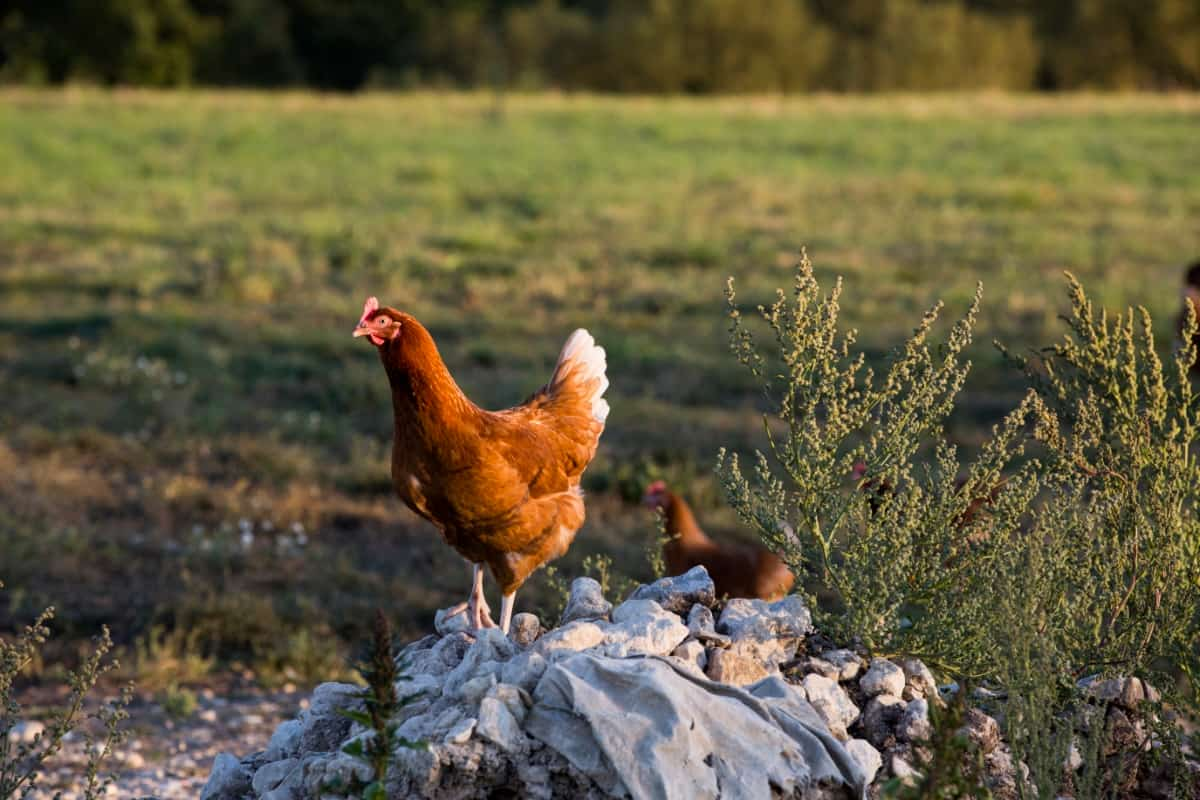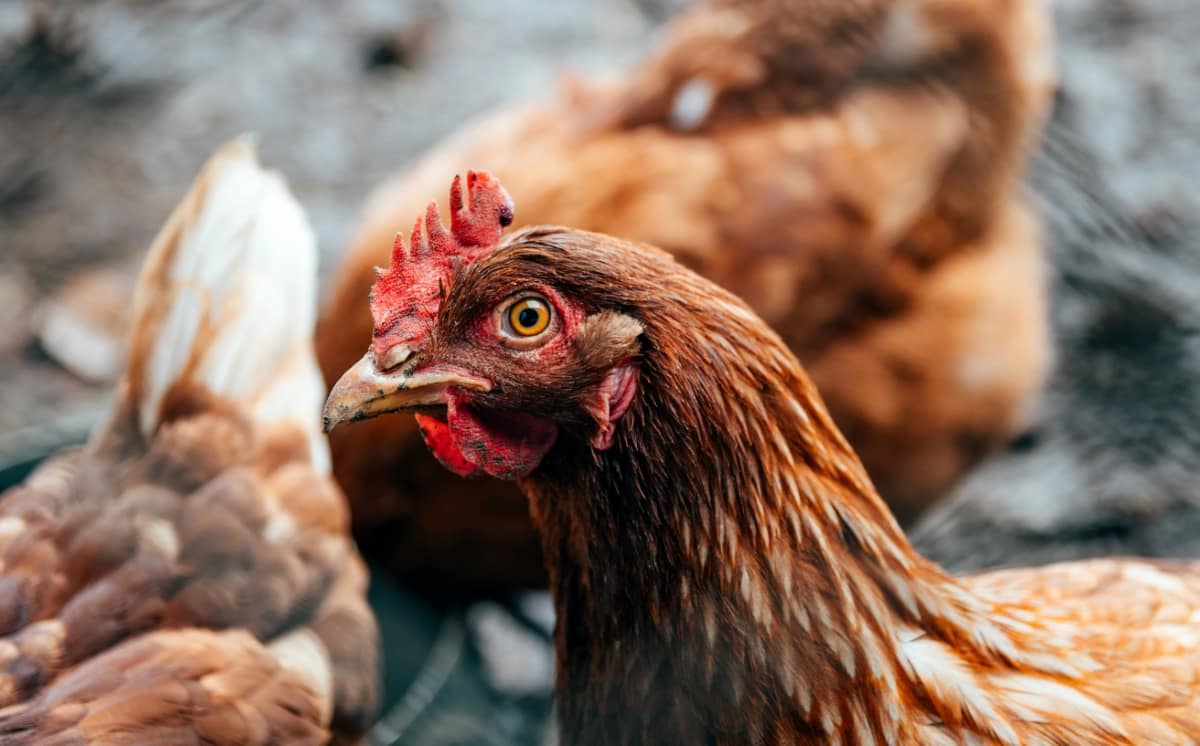These charming birds are renowned for their prolific egg production and friendly disposition, making them popular among poultry keepers. The Hisex is a dual-purpose chicken, and its ability to produce large quantities of eggs and meat. They are known for their docile temperament, which makes them great for families with children.

Guide to Hisex Chicken
Characteristics of Hisex Brown and Hisex White Chicken
- The Hisex chicken breed is popular for those looking to raise chickens for their eggs. This is largely due to the prolific egg production of both the white and brown varieties.
- Hisex brown and Hisex white chickens are two of the most popular varieties in the Hisex chicken breed. The difference between the two varieties is their color and weight.
- The Hisex White is pure snow-white, while the reddish-brown color coats all regions of a Hisex Brown’s body with occasional white tips on its feathers edge.
- Both chickens have exceptional egg production capabilities, making them ideal for commercial farming. In terms of temperament, they are quite docile and easy to manage compared to other breeds.
- One unique characteristic that sets these chickens apart is their ability to thrive in different environmental conditions. They can adapt well to cold or hot climates without compromising their health.
Hisex Chicken Egg Production
The Hisex White variant can lay around 330-350 white-colored eggs per year, while the brown variety lays almost as many, with approximately 360 eggs produced annually.
This level of egg production makes Hisex Chickens some of the most productive breeds out there, perfect for hobby farmers or commercial egg producers.
Hisex Chicken Behaviour
- Hisex chickens are known for their gentle and docile nature, making them a great addition to any flock. They are friendly birds that enjoy being around humans and other animals. Even though they are generally calm, it is still important to handle them with care.
- These chickens have strong social bonds and thrive in flocks. When kept alone, they tend to get bored easily, which can lead to destructive behavior such as feather picking or egg eating.
- Hisex chickens are moderate compared to other breeds. They enjoy taking dirt baths, scratching the ground for food, and perching on branches or roosts at night.
- As with most chicken breeds, Hisex also has its unique personality quirks. Some individuals may be more curious than others, while some may be more vocal than the rest of their flock mates.
- Providing a safe environment for your Hisex chickens will help ensure good behavior from these friendly birds.
Hisex Chicken Weight
The Hisex chicken breed comes in two variants- white and brown. The base color of Hisex White is snow-white, which covers both male and female chickens. The average weight of a male Hisex White variant is around 1.8 kg, while the hen weighs approximately 1.7 kg during egg production.
In case you missed it: Ultimate Guide to Sundheimer Chicken Breed: Characteristics, Feed, and Care

Compared to the white variant, Brown Hisex roosters and hens have heavier weights ranging from 2.4kg for males to around 2kg for females. Understanding your bird’s weight is crucial when caring for them, as different sizes require varying nutritional needs and housing accommodations. Therefore, keeping an accurate record of your flock’s weight can help you make informed decisions about how best to care for them.
Hisex Chicken Raising Care
- Taking care of Hisex Chickens is essential to ensure their health and productivity. Providing your birds with clean and comfortable living space is the first step toward proper care. Ensure that the coop or cage you keep them in is spacious enough, well-ventilated, and free from sharp objects.
- You should also regularly clean their living area by removing droppings, changing bedding, and disinfecting surfaces. This helps prevent the spread of diseases among your flock and keeps them healthy overall.
- Feeding Hisex Chickens with a balanced diet is crucial for their growth and egg production.
- Monitoring your chickens’ behavior daily is important to see if they show signs of illness or distress. Look out for changes in eating habits or weight loss, as this could indicate something isn’t right.
Feeding Tips for Hisex Chickens
- Feeding Hisex Chickens is critical to maintaining their health and achieving the desired egg production rate. A balanced diet provides all the nutrients for chickens to live a healthy life, including protein, carbohydrates, vitamins, and minerals.
- It is recommended that Hisex Chickens be fed with high-quality commercial chicken feed as it contains a balanced mix of nutrients essential for optimal growth and egg production. In addition to commercial feeds, Hisex Chickens can be given supplemental treats such as fruits, vegetables, or grains.
- Chickens always require access to water; hence, providing clean drinking water is crucial in preventing dehydration-related illnesses. It’s important to ensure the waterer remains clean and free from contaminants like dirt or feces.
- Overfeeding can lead to obesity which may cause decreased egg output or other health problems over time. On the other hand, underfeeding may cause stunted growth rates or even death due to malnutrition.
Health Care Tips for Hisex Chickens
- Providing your chickens with a clean and safe living environment is important. This means regularly cleaning their coop, providing them with fresh water daily, and ensuring they have access to a balanced diet.
- Another important aspect of caring for Hisex chickens is monitoring their behavior and overall health. If you notice signs of illness or unusual behavior in your birds, finding these issues as soon as possible is important. Some common signs of illness in chickens include lethargy, loss of appetite, respiratory problems, diarrhea, or abnormal feces.
- Preventing diseases such as Marek’s disease can also be achieved through vaccination at an early age and implementing strict biosecurity measures on your farm, including controlling movement onto/off the farmyard, such as people & vehicles.
- Additionally, hygiene standards are observed during egg collection by washing hands thoroughly before entering pens and not forgetting sanitizing equipment used for egg handling/packaging, which helps control contamination risks from bacteria like salmonella on eggs offered for human consumption.
- Monitoring your chickens for any signs of illness or injury is also important. Look for unusual behavior such as lethargy, reduced appetite, or feather loss. Addressing these issues early on can prevent further complications down the line.
In case you missed it: Ultimate Guide to Amrock Chicken Breed: Characteristics, Feed, and Care

Conclusion
Hisex chickens are widely used worldwide by commercial farmers for their high-quality eggs and meat production capabilities. The breed’s success is attributed mainly to its genetic makeup, allowing it to adapt well to various environments while maintaining optimal health and productivity. They became known for their ability to lay large numbers of eggs while consuming less food than other breeds.
- Ultimate Guide to Ossabaw Island Hog: Breeding, Raising, Diet, and Care
- Ultimate Guide to Juliana Pig: Raising Facts, Size, Diet, Care, and Lifespan
- Raising Lleyn Sheep: Disadvantages, Price, Uses, Characteristics, and Care
- Ultimate Guide to Meishan Pig: Breed Facts, Breeding, Raising, and Care
- Ultimate Guide to Teacup Pigs: Raising, Diet, Lifespan, Cost, and Care
- Guide to Raising Poll Dorset Sheep: Facts, Profile, Characteristics, Uses, and Care
- Ultimate Guide to Bighorn Sheep: Characteristics, Diet, Lifespan, Breeding, and Lifecycle
- Ultimate Guide to Raising Katahdin Sheep: Farming Facts, Breed Profile, Uses, and Care
- Ultimate Guide to Raising Oreo Cows: Belted Galloways Farming Facts, Profile, Uses, and Care